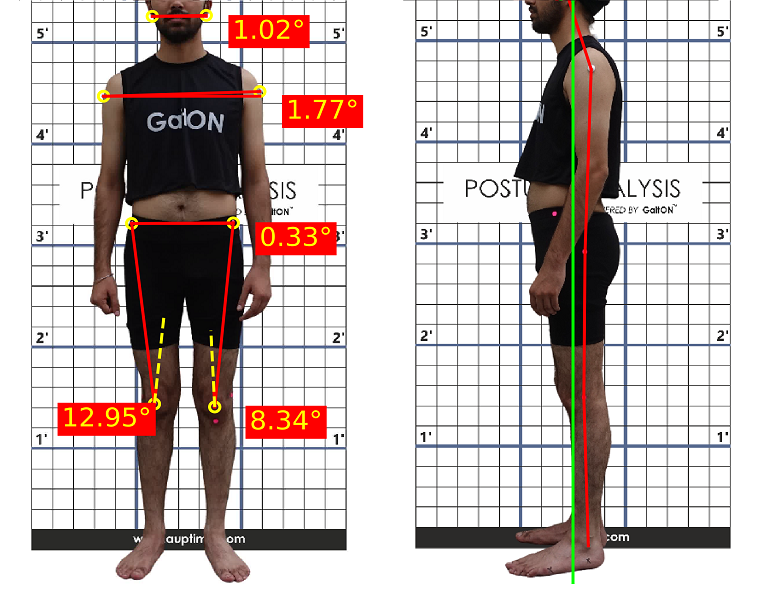Posture
Posture refers to the position in which you hold your body while standing, sitting, or lying down. It is the way your body aligns and balances itself to maintain stability and proper alignment of your bones, muscles, and joints. Good posture means that your body is in an optimal position that minimizes stress on your muscles, bones, and ligaments while allowing you to move and breathe efficiently. Poor posture, on the other hand, can lead to a range of health problems such as back pain, neck pain, and headaches. Therefore, maintaining good posture is important for overall various healthcare professionals can assess posture, including:
- Physiotherapists: These are healthcare professionals who specialize in helping people recover from injuries and manage chronic conditions that affect their movement and posture.
- Chiropractors: These are healthcare professionals who focus on the diagnosis and treatment of conditions related to the musculoskeletal system, including the spine and joints.
- Osteopaths: These are healthcare professionals who use hands-on techniques to manipulate and mobilize the musculoskeletal system to improve posture and alleviate pain.
WE AT KURE CLINIC USE AI TO DIAGNOSE POSTURAL DEFECTS
Artificial intelligence (AI) can help in diagnosing a wrong posture in several ways. Here are some examples:
- Computer vision: AI algorithms can be trained to analyze images or videos of a person’s posture and detect deviations from optimal alignment. For example, an AI system could analyze a person’s gait while walking and detect issues such as an uneven stride, a hip drop, or a forward head posture.
- Wearable devices: AI-powered wearable devices, such as smartwatches or posture sensors, can track a person’s posture throughout the day and provide feedback on how to improve it. These devices can also use AI algorithms to analyze the data they collect and provide insights into a person’s posture habits and patterns.
- Virtual coaches: AI-powered virtual coaches can provide personalized feedback and guidance to people who want to improve their posture. These coaches can use data from wearable devices or computer vision systems to identify areas where a person needs to make adjustments and provide real-time feedback and suggestions for improvement.
Overall, AI has the potential to be a valuable tool in diagnosing and correcting posture issues, providing personalized feedback and guidance, and helping people maintain good posture habits over time.
Physiotherapy can be an effective treatment for correcting posture issues. Here are some common physiotherapy techniques used to improve posture:
- Manual therapy: This involves hands-on techniques, such as muscle release or joint mobilization, to improve joint mobility and alignment, release tension in muscles, and improve posture.
- Strengthening exercises: Physiotherapists may prescribe exercises to strengthen the muscles that support good posture, such as the core, back, and gluteal muscles.
- Stretching exercises: Tight muscles can contribute to poor posture, and stretching exercises can help to lengthen these muscles and improve flexibility.
- Postural education: Physiotherapists can educate patients about proper posture and how to maintain it throughout the day, including when sitting, standing, and walking.
- Ergonomic assessments: Physiotherapists can assess a patient’s workplace or home environment and make recommendations for ergonomic modifications that can improve posture, such as adjusting chair height, adding lumbar support to a chair, or using a standing desk.
- Biofeedback: This technique involves using sensors to provide feedback to patients about their posture and movement patterns. The feedback can help patients learn to recognize and correct poor posture habits.
Overall, physiotherapy at KURE CLINIC treatment can be customized to meet the individual needs of patients and address the specific underlying causes of their posture issues. It can also help to prevent future posture-related problems by educating patients about proper posture habits and providing them with exercises and techniques to maintain good posture over time.
Top of Form
Chiropractors can help to improve posture by using techniques that focus on the musculoskeletal system, particularly the spine and joints. Here are some common chiropractic techniques used for posture correction:
- Spinal adjustments: Chiropractors use manual manipulation techniques to adjust the alignment of the spine and reduce any misalignments or subluxations that may be contributing to poor posture.
- Joint mobilization: This involves moving the joints through their full range of motion to improve joint mobility and alignment.
- Soft tissue therapy: Chiropractors may use massage or other soft tissue techniques to relieve tension in muscles and improve posture.
- Postural assessments: Chiropractors can assess a patient’s posture and identify any areas of imbalance or tension that may be contributing to poor posture.
- Lifestyle modifications: Chiropractors may recommend changes to a patient’s lifestyle, such as improving their diet, incorporating exercise, or making ergonomic modifications to their work environment to improve posture.
Overall, chiropractor Dr. ESHAN KAUSHIK at KURE CLINIC can provide personalized care to address the underlying causes of poor posture and help patients develop healthy posture habits. Chiropractic treatment can also help to alleviate any pain or discomfort associated with poor posture, improve joint mobility and flexibility, and enhance overall physical function.
